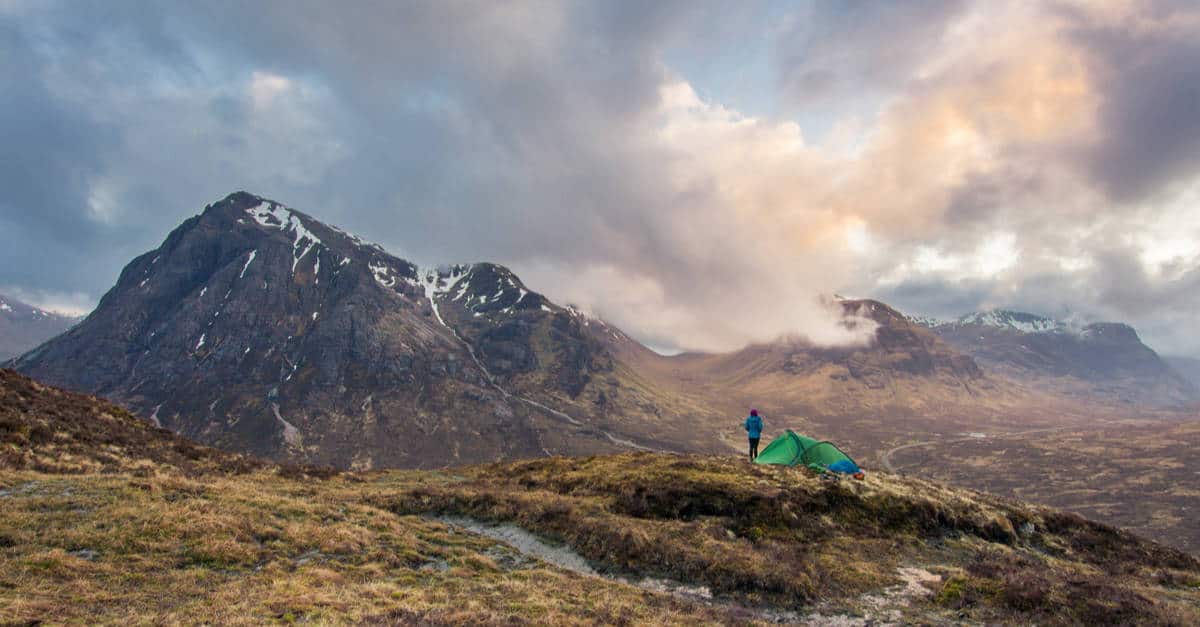Wild camping in the UK offers an uplifting sense of freedom and remoteness, unlike anything else. Many outdoor enthusiasts will tell you that there’s no better way to reconnect with nature but by sleeping under the stars. And if you’re interested in places for wild camping in the United Kingdom, you’ve come to the right place.
In this article, I’ll be taking a thorough look at the UK’s top 10 spots for wild camping. In addition, I’ll provide you with a general overview of laws and regulations you need to be familiar with before heading out into the wild. So, without further ado, here are the best places in the UK for those who want to wander off the beaten track and spend some nights in spectacular countryside.
Map of Wild Camping Locations in the UK
Click on the map icons for more information about each wild camping area.
1. The Isle of Skye, Scotland
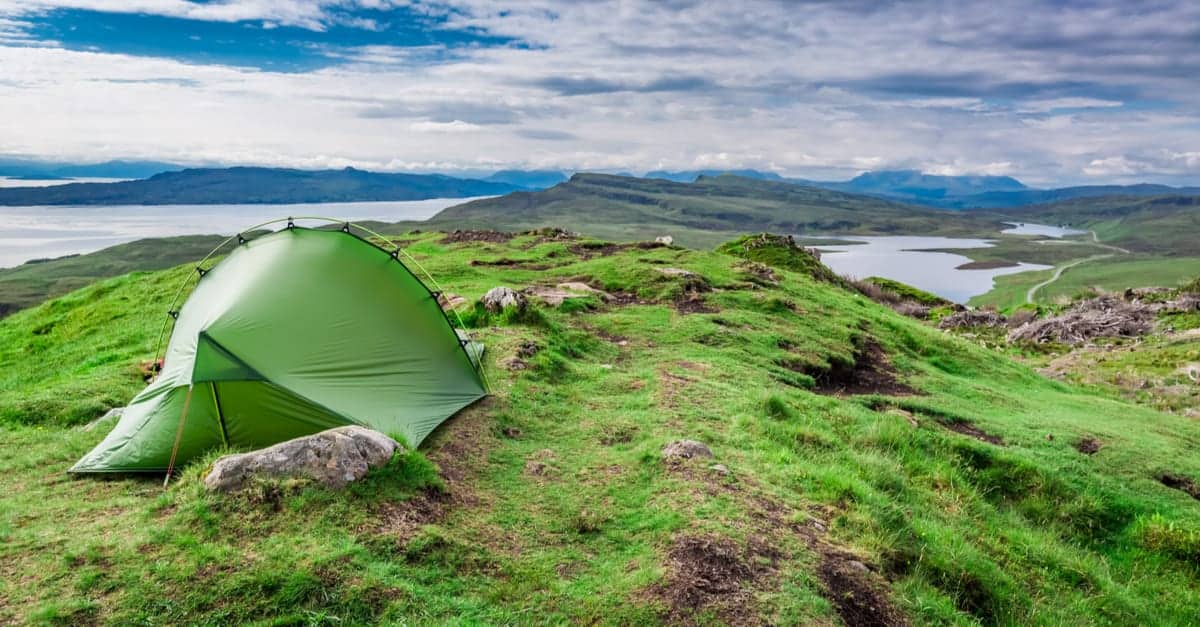
Let’s be honest here, Scotland has so many incredible wild camping spots that it’s impossible to choose just one, so I’ll list a couple of them. The first of these are the many beautiful Isle of Skye wild camping areas, one of Scotland’s largest and most beautiful islands. The island has a very long and rich history and is now one of the most popular tourist destinations in the whole country.
While it’s true that the weather on the Isle of Skye is unpredictable, those willing to brave the conditions are guaranteed to be rewarded with genuinely unforgettable sights. In my opinion, the best spots for wild camping on the Isle of Skye are Quiraing and Camasunary.
Formed by a (still moving!) ancient landslip, Quiraing is a plateau that features a series of breathtaking rock pinnacles, with “The Needle” being the largest of all rock columns in the area. Camasunary, on the other hand, is a perfect spot for those who want something a bit more tranquil – it’s a magnificent bay situated on Skye’s southern coast and a great spot to spend a night or two after a day of Munro Bagging.
Alternatively, you can camp on the Isle of Arran. Check out my guide to wild camping in Scotland as well for more information about many other locations in Scotland.
2. Dartmoor National Park, England
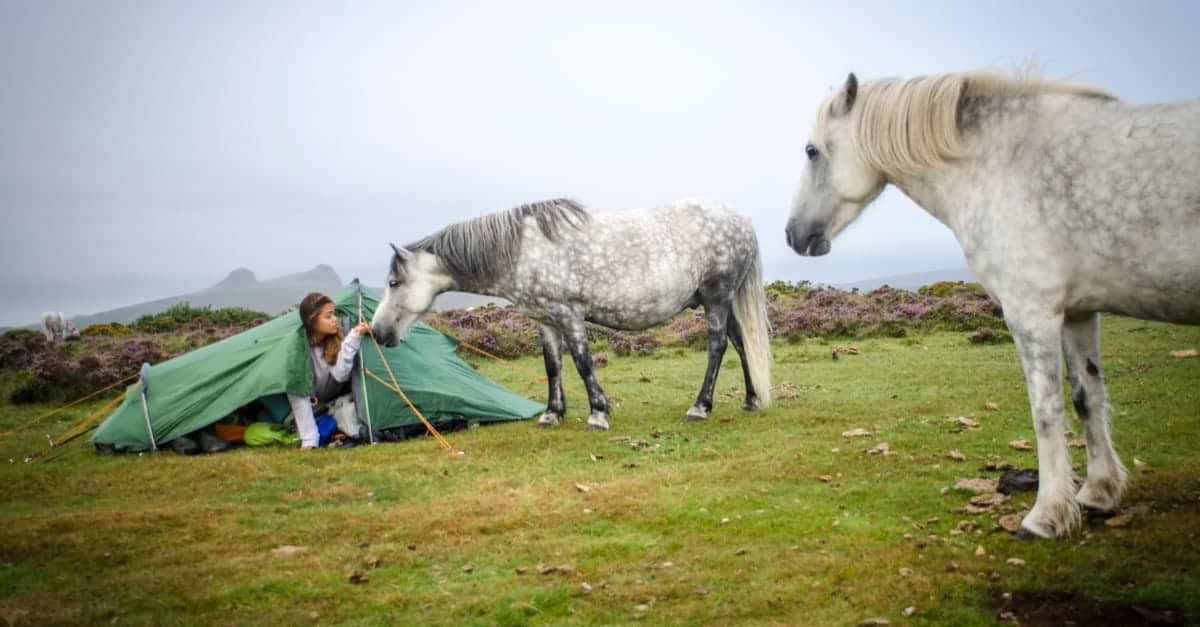
Wild camping in Dartmoor National Park in southern Devon is completely legal in certain designated areas. Dartmoor is well-known for its legends and myths, and is reputedly a dwelling of “hellhounds”. As you probably already know, such stories were the main source of inspiration for Sir Arthur Conan Doyle when he was writing The Hound of the Baskervilles, which is probably the most famous out of all Sherlock Holmes novels.
Two of the park’s most popular wild camping areas are Riddon Ridge and Bellever. However, those planning to head over to these places should know that it’s extremely important that they leave no trace there – in 2020, wild camping was temporarily banned in these areas due to huge amounts of used toilet paper, wet wipes, disposable barbecues, plastic bags, broken bottles, and other garbage left behind by irresponsible campers.
Other great spots include Ugborough Moor and Yes Tor. Both of these provide breathtaking, uninterrupted views of the moors. However, if you want to be closer to civilization, your best bet is to set up camp on the high ground above Ivybridge, from where you’ll be able to see the town itself and the surrounding countryside.
3. Exmoor National Park, England
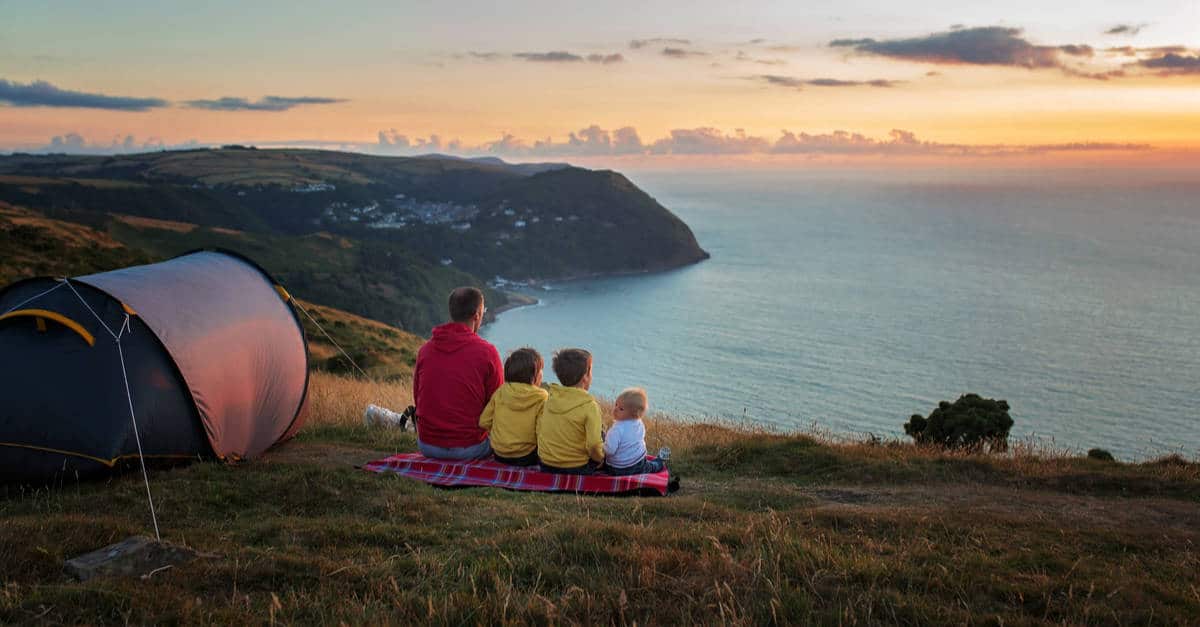
Located in the north of Devon and the west of Somerset, the Exmoor National Park is one of the favorite destinations for wild campers and an area that is used by outdoor enthusiasts for all kinds of recreational purposes. The area has over 30 miles of coastline and is full of woodlands, waterfalls, ravines, rocky headlines, and towering cliffs.
Some of the best wild camping spots in this astounding region include Watermouth Bay, Porlock, and Dunster. Out of these, I consider Watermouth Bay to be the best – it’s a secluded, sheltered harbor that provides wild campers with unforgettable, picture-perfect views of the Bristol Channel. Did you know that the rugged rocks and magnificent caves of this area have inspired Enid Blyton to write many of her Famous Five stories?
One particularly great thing about wild camping in this part of the United Kingdom is that it enjoys the darkest skies in the entire country. Pretty impressive, wouldn’t you say? If you also love stargazing, wild camping in Exmoor National Park is undoubtedly your best option. Just don’t forget to obtain the landowner’s permission before setting up your camp!
Wild camping in Devon, particularly in places like Exmoor, offers a delightful blend of natural serenity, abundant wildlife, and enchanting folklore. Its verdant rolling hills, sprinkled with wild ponies and punctuated by majestic views of the sea, provide an unparalleled outdoor experience. As you nestle down beside a softly babbling brook under a clear night sky, the peacefulness of Devon’s wild camping scene will effortlessly imbue your adventure with an essence of pure tranquility and rare magic.
4. Lake District, England
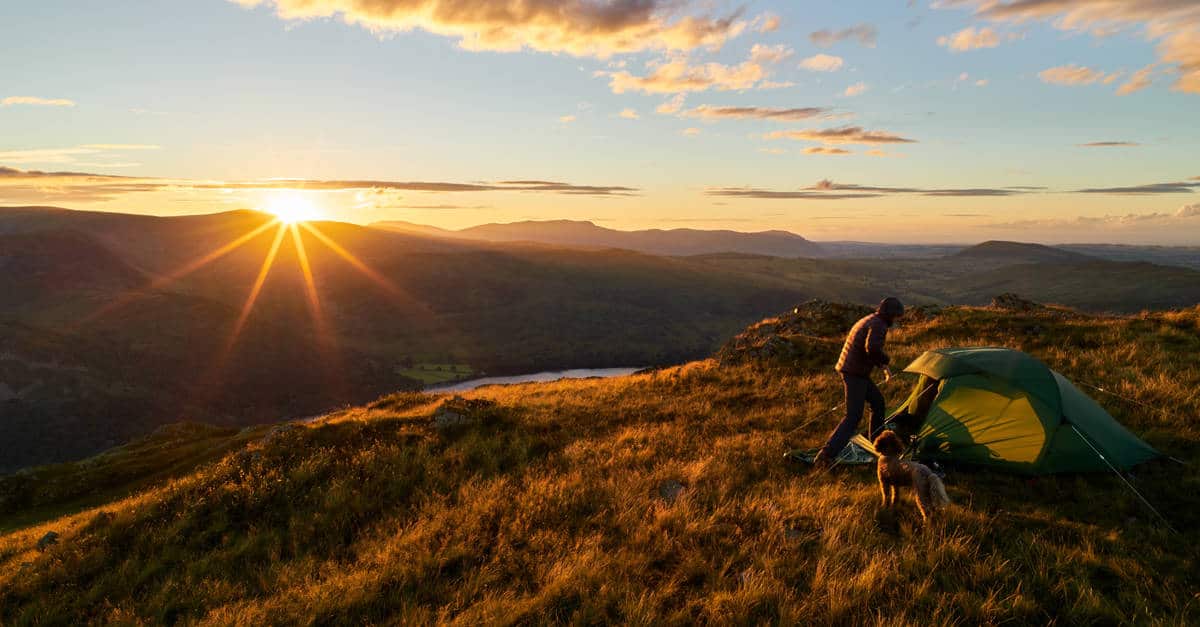
If you ask an English hiker what’s his or her favourite place to hike in England, a lot will probably tell you that it’s the Lake District. Situated about 100 miles north of Manchester, in North West England, this mountainous region is well-known for its sensational lakes, fells, and forests and is, therefore, an extremely popular holiday destination.
As you can already guess, this also means that wild camping in the Lake District is very, very busy between spring and autumn. There are no designated wild camping spots in this region, but as long as you set up your camp high up in the mountains and stay out of people’s way, you shouldn’t encounter any major issues. However, as I’ve already said, chances are that these spots will already be taken if you get there too late.
For that matter, I recommend heading over to the Western Fells and the Ennerdale Valley. There, you should be able to wild camp in the woodlands and enjoy a much quieter time. Another good option is the wondrous lake called Codale Tarn, which is somewhat tricky to reach and, therefore not likely to have any people camping along its shores.
5. The Brecon Beacons, Wales
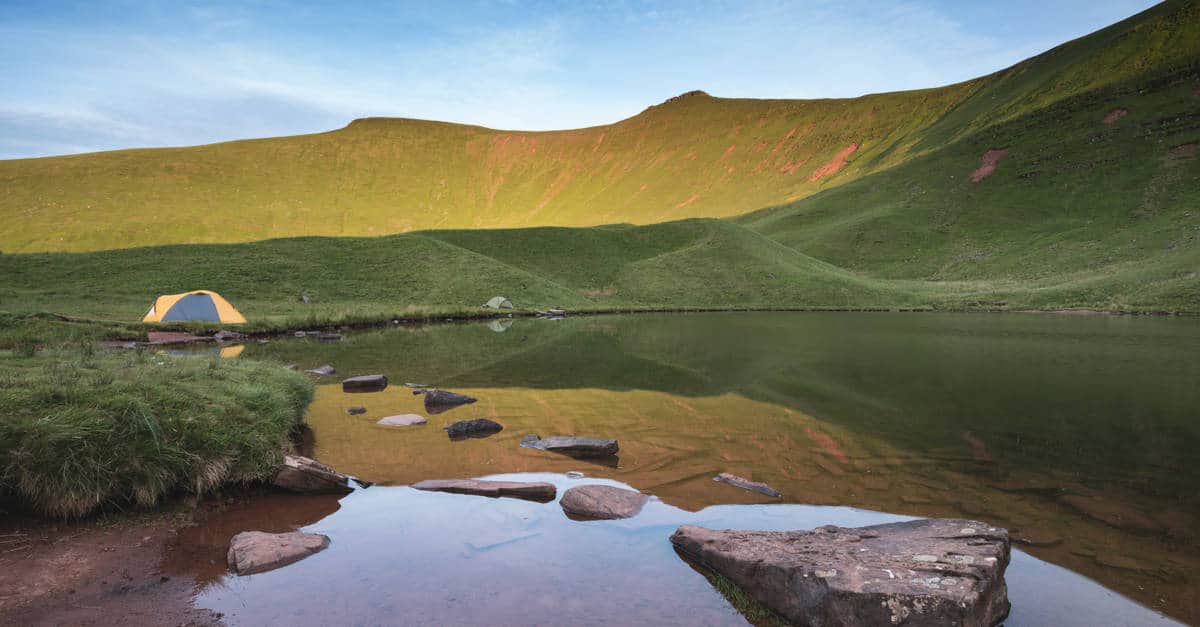
In my opinion, Wales is definitely the most overlooked when it comes to wild camping. Wales offers some of the most breathtaking scenery on the entire island of Great Britain, particularly in its three national parks – Pembrokeshire Coast, Snowdonia (we’ll talk more about it later), and the Brecon Beacons, whose gorgeous views are very hard to beat.
The Black Mountains, which extend all the way into England, offer some of the wildest terrains in the Brecon Beacons and are a phenomenal destination for those who are really serious about wild camping. Reach Mynydd Bychan, pitch your tent there, and sleep under the stars. Or, if you’re feeling a bit more adventurous, hike up to the highest point of the Chwarel y Fan Ridge – Rhos Dirion – for a genuine summit sleep.
Another popular hiking route in this part of Wales is the Fan y Big circular walk and one that will take you into the very heart of the Brecon Beacons. Don’t forget to bring your money, though – there’s always a good chance of bumping into one of the local farmers, and these guys rarely skip a chance to ask wild campers for a couple of pounds in return for allowing them to stay on their properties. Read our guide to wild camping in Brecon Beacons for more information.
6. The Cairngorms, Scotland
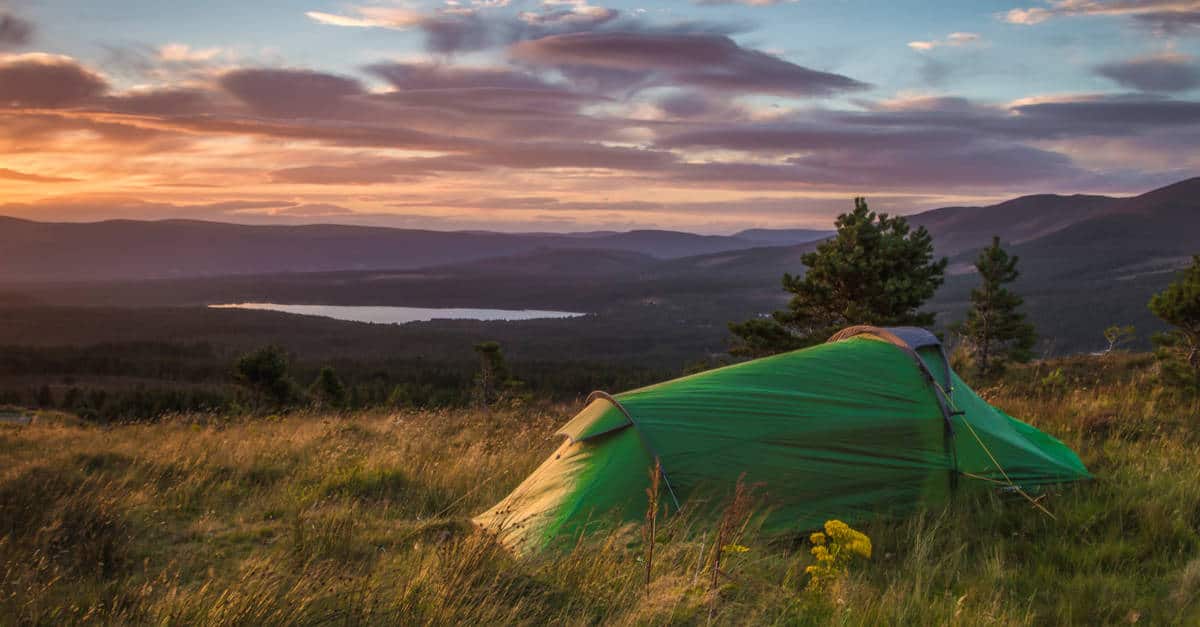
The Cairngorms are a mountain range that’s in the heart of the Cairngorms National Park. Besides the titular mountains, the park also consists of hill ranges like Monadhliath and Angus Glens, but also lower regions such as Strathspey. As you can already guess, the region is extremely picturesque and is popular for climbing, ski touring, and hill walking.
Since it covers a massive area of almost 2,000 square miles, wild camping in this park is fair game – as long as you’re not doing it in enclosed spaces. Unlike the rest of the United Kingdom, Scotland’s unencumbered by-laws and restrictions concerning wild camping (more on that later), so you’ll have no trouble wild camping in the Cairngorms as long as you’re behaving responsibly.
In our opinion, one of the best wild camping spots in this charming Highlands region is Glen Feshie, situated some 20 miles north of Pitlochry. Glen Feshie is home to one of Scotland’s most prosperous “rewilding” plans and is bound to take your breath away with its sweeping mountain vistas and tumbling waterfalls. In addition, this place is the starting point of many hiking trails, allowing you to go on a walk straight from your campsite. Another to consider is wild camping in Glencoe.
7. Loch Lomond and the Trossachs, Scotland
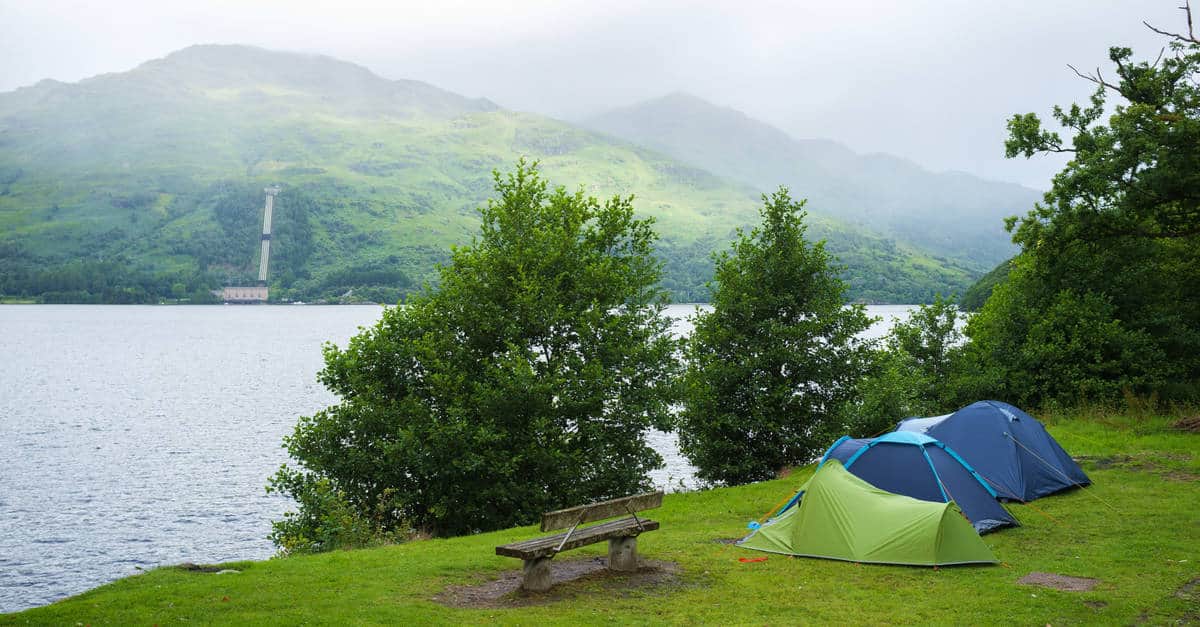
With over 50 streams and rivers, 21 peaks over 3,000 feet, and 22 lochs, Scotland’s second-largest national park is a true paradise for every outdoor enthusiast. What is more, it is a lot more accessible than the Cairngorms National Park – it takes only a bit over half an hour to reach Loch Lomond and the Trossachs National Park by car from Glasgow. There are two distinct regions in this park – highland and lowland – and the Highland Boundary Fault separates these.
Some of the park’s more popular wild camping spots are all but secret, so finding a place where you’ll be able to sleep under the stars far from other hikers can be quite difficult. In fact, some of these spots are so popular with outdoor enthusiasts that they became among Scotland’s very first open spaces to be regulated by special laws. There’s nothing you need to worry about here, though – the permit costs just £3.
Furthermore, these special laws cover just 4% of the park’s total area, so there are plenty of beautiful spots where you’ll be able to wild camp at Loch Lomond without risking a fine. Just make sure to camp away from enclosed fields and take any rubbish with you. Also, try not to disturb the park’s wildlife and avoid lighting fires – use a portable stove instead. When it comes to answering the call of nature, make sure to bury the waste with a trowel and do it as far away from water sources as you can.
For those keen on wild camping near Glasgow, there are a few spots just on the outskirts of the city. Yet, the allure of Loch Lomond and the Trossachs National Park, with its expansive landscapes and untouched beauty, often draws those looking for a more immersive wild camping experience away from the city’s hustle and bustle.
8. Snowdonia, Wales
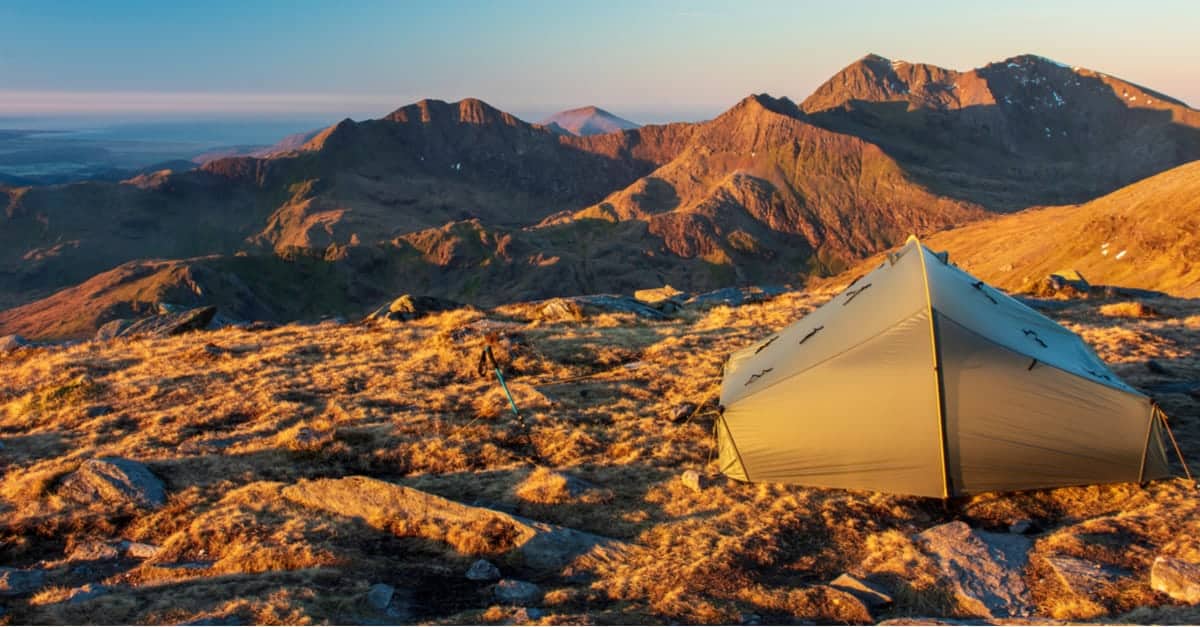
Covering an area of 823 square miles, Snowdonia is one of the three national parks situated in Wales. The park’s name comes from the highest mountain located in it – Mount Snowdon – which is also the highest mountain in Wales. Even though there are over 20,000 people living in the park and there’s a notable amount of agricultural activity within it, most of the land is mountainous and open.
It is precisely this mountainous character of Snowdonia that turns it into a phenomenal choice for those who’d like to combine wild camping with some mountain climbing. Mount Snowdon, which we have mentioned above, is 3,560ft high and ready for taking – it’s a challenging climb, but the scenery is more than worth it. The park is exceptionally lenient to those interested in wild camping – you’ll have no trouble as long as you’re staying away from regular walking tracks.
One of our favourite wild camping spots in Snowdonia is the Carneddau range. There, you will find a mix of heather and grass, as well as rivers and lots of space for setting up your camp. In case you’re looking for some additional shelter, on the other hand, check out the Dulyn Bothy, which is located just to the east of Llyn Dulyn Lake.
9. Sutherland, Scotland
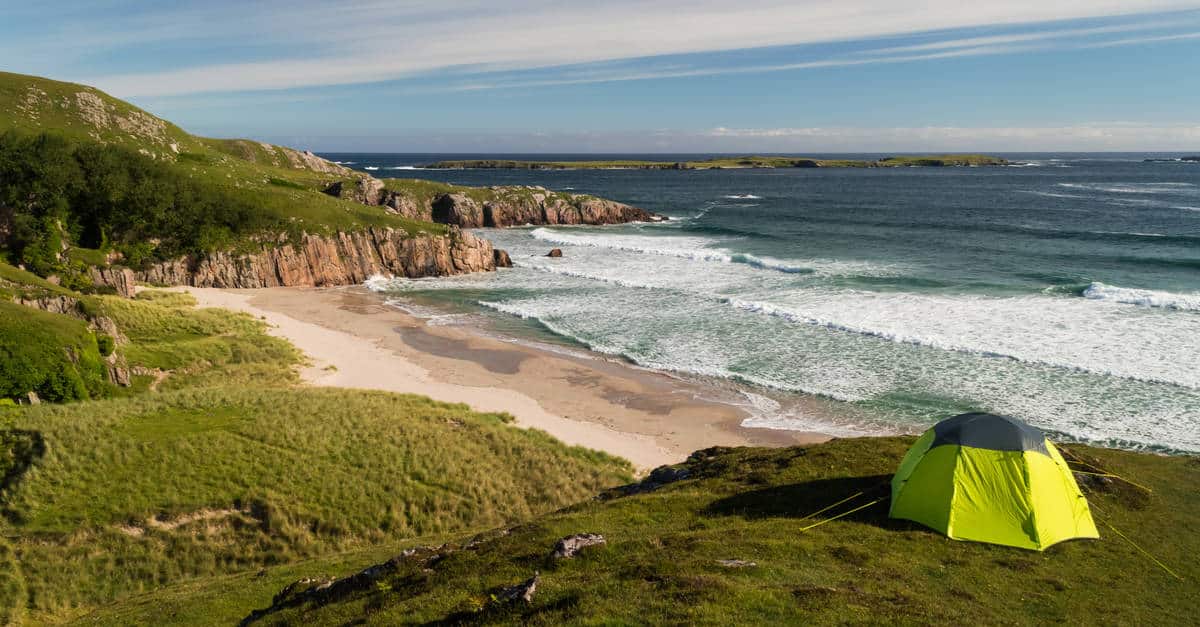
Sutherland is a region that’s situated in the far north of Scotland and is one of those places that is genuinely off the beaten track. Here, you will find no chain restaurants, swanky hotels, or even industry – most of Sutherland’s villages have less than 100 residents. In addition, the number of A-roads in Sutherland can be counted on one hand, and you’re not that likely to see a car or a motorcycle in this faraway region.
However, this sparsely populated area immediately strikes the visitor with the sheer diversity of its landscape: rivers, glens, lochs, marshy peatlands, heather-covered moors, standing stones, ruined castles, as well as three coastlines – west, east, and north. And on Sutherland’s western coast is one of the best spots for wild camping in the entire United Kingdom – Sandwood Bay.
This place has everything a person interested in this type of activity may want – crashing saltwater waves and rugged rock faces, as well as a 4-mile hike to get there. The beach of Sandwood Bay is probably the cleanest in the entire country. It is, in our opinion, a phenomenal spot for all those who want to spend a night under the stars. Don’t forget to explore the peaceful wilderness while you’re there, too!
10. Cheviot Hills, England/Scotland
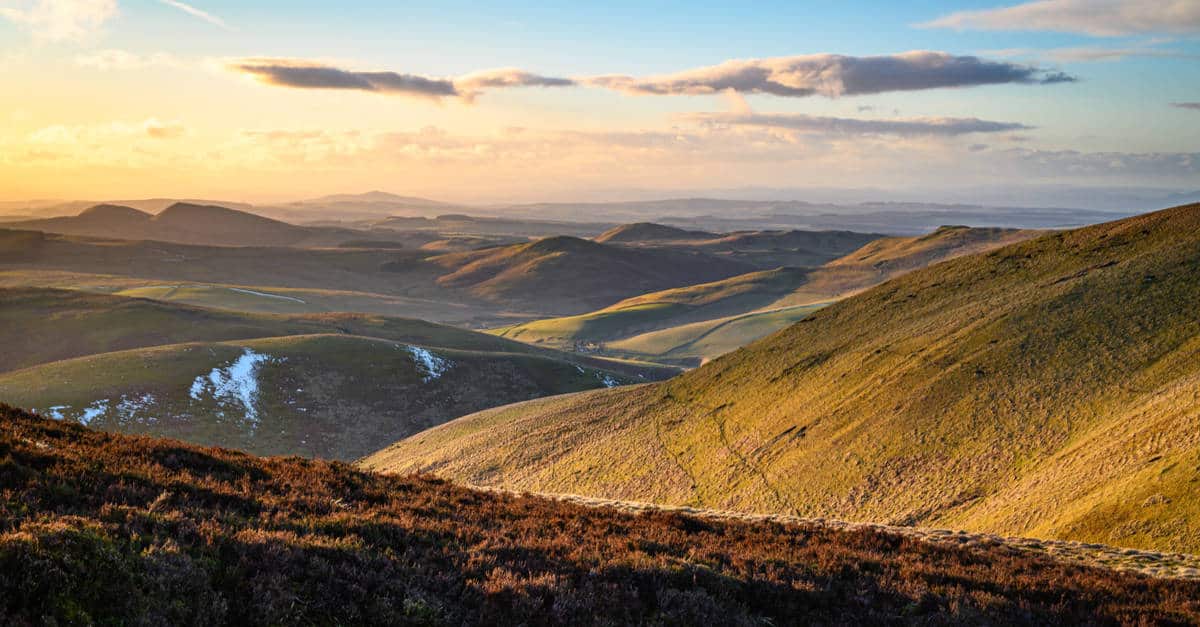
How often do you have a chance to have an outdoor adventure in two counties at once? That is precisely what you can do if you head over to the Cheviot Hills, which are situated on the border between the Scottish council area called the Scottish Borders and the English historic county called Northumberland.
The entire area is mapped as “open country” by both England and Scotland, but we advise you to wild camp only on the Scottish side since the regulations are in favour of wild camping, unlike the rest of the UK. One of the easiest (and best) ways to access the Cheviot Hills is by hiking the Pennine Way – you can easily reach these rolling hills from either Kirk Yethold to the north or Byrness to the south.
In any case, this area has a lot to offer to wild campers. Stunning scenery is guaranteed to all those who decide to pay a visit to the College Valley, while those looking for wildlife should head over to the Harthope Valley, which is one of the region’s best places for bird watching. While exploring the Cheviot Hills, make sure to also walk the short Kirknewton Hillfort Trail and see the remains of an ancient Iron Age fort, as well as pay a visit to the Linhope Spout, which is one of the most spectacular waterfalls in this part of England.
Other notable places:
What Exactly is Wild Camping?
To put it simply, wild camping (also known as rough camping) is a term that describes camping outside of regular campsites. As its name suggests, wild camping means pitching your tent in the wilderness, i.e. in an unused, uninhabited area that’s typically miles away from civilization.
While this type of activity may not sound like an attractive idea to just anybody, wild camping has definitely experienced a rise in popularity in recent years. A lot of outdoor enthusiasts are now opting for wild camping instead of regular camping, as they’re searching for freedom and peace in areas that are quiet and far away from other campers and trekkers. To have a successful wild camping adventure, one doesn’t have to be an experienced outdoorsman – all you need is a bit of common sense and the right equipment.
However, before you throw a portable stove into your backpack and head over to one of the 10 destinations we’ve listed above, there are a couple of things you’ll need to keep in mind if you want to stay out of trouble with the law. Be sure to check out our guide to wild camping essentials as well.
The Law on Wild Camping in the UK
If you’ve been researching wild camping in the United Kingdom, you’ve probably seen that many websites just describe how unlawful this activity is. In truth, wild camping is actually a completely legal outdoor activity, although it is accompanied by a set of strict rules that every wild camper needs to follow. It is extremely important that you thoroughly plan your outing and do your research if you want to avoid getting fined.
Technically, all land in the three out of four countries that constitute the United Kingdom (all except Scotland) belongs to somebody. This is why it’s vital that you obtain the landowner’s permission before pitching your tent on their land. As with all other things, there are some exceptions – in the wilds of Scotland and on the unenclosed land in the already-mentioned Dartmoor National Park, one can engage in wild camping without any worries. The rules in Dartmoor have changed but are still in flux. I will update this with more information as the situation progresses.
Across the United Kingdom, there are a lot of plots of land that you can wild camp on without anybody giving you trouble. However, even though this goes without saying, common sense is always needed, if someone asks you to move just move on. Always try to obtain the landowner’s permission, respect “private land” signs you encounter, and never camp close to people’s homes and roads.
In Which Cases Is Wild Camping Illegal?
As we’ve mentioned above, wild camping in the UK becomes illegal if you do it on someone’s land without obtaining the landowner’s permission first, i.e. when you’re trespassing. Always keep in mind that even though the law may forbid you to wild camp in a certain area, there is always a chance to come up with a mutual agreement with the landowner and be allowed to camp there anyway. Sounds confusing, doesn’t it?
Here’s an example – let’s say you’re planning to wild camp in England’s world-famous Lake District. Even though the official website of the Lake District encourages you to do so, it also states that the Lake District National Park Authority is in no power to allow outdoor enthusiasts to set up their camps on private plots of land.
So, what does this mean? Is it possible to wild camp in the Lake District or not? It is possible, and the reason behind that is in the fact that the Park Authority, which we have mentioned above, has an understanding with the locals – you can wild camp in this area for as long as you’re well-behaved and respectful.
Don’t quote us on this – it’s a rule of thumb. However, using common sense while wild camping will almost always put you out of trouble with the law. The vast majority of landowners won’t see you as an illegal trespasser if you talk to them first and if you don’t cause them any problems while camping on their properties. Also, don’t forget to take into account other regulations, like the ones concerning campfires and other things.
What About Wild Camping in Scotland?
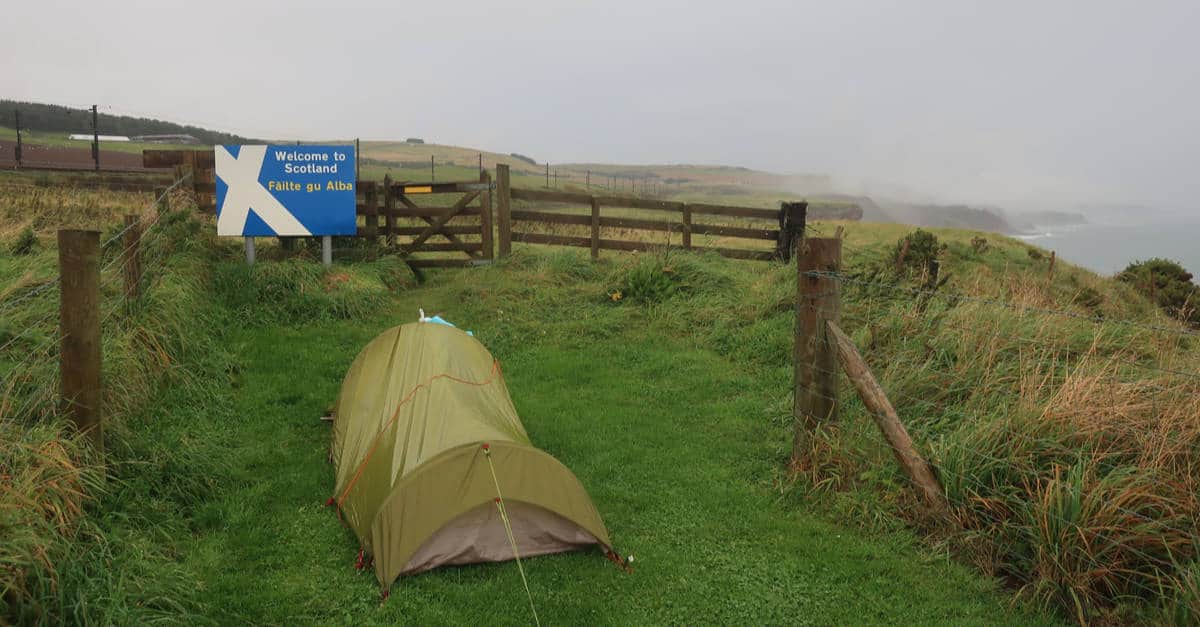
Sadly, if you’re a wild camping enthusiast, you won’t be able to set up your camp just anywhere you want in Scotland. While it’s true that wild camping in Scotland, unlike Northern Ireland, Wales, and England, isn’t encumbered by laws and restrictions that forbid wild camping, some irresponsible campers have caused tensions to rise over recent years.
Wild camping in some areas of Scotland, like the famous Loch Lomond and the Trossachs National Park, can’t be done without special permission. In other words, it is possible to wild camp in almost all of Scotland, but wild campers need to be cautious while doing so.
But still, just like when it comes to camping in other regions of the UK, camping in Scotland should not be done without researching whether you need to obtain permission for a specific area first. Of course, you also need to be a responsible wild camper and work extra hard to ensure that the spot you’ve chosen for your camp looks exactly the same as it did once you’re gone.
Obviously, those not using a vehicle for their wild camping adventures can enjoy slightly more freedom. While you won’t be able to pitch your tent in somebody’s play park or garden, Scotland’s right-to-roam regulations allow adventurers to use the majority of spaces for camping thanks to a mutual trust that is supported by something called SOAC – the Scottish Outdoor Access Code.
The Scottish Outdoors Access Code
Nowadays, every individual has the right to roam the Scottish countryside thanks to the Land Reform Act (2003). In other words, people who want to explore the Scottish wilderness can absolutely do so for as long as they don’t abuse this entitlement.
The SOAC plays a crucial role in defining how one can ensure that his privilege to roam the Scottish countryside remains intact. In other words, this code is actually a very detailed guide that provides a ton of information on the responsibilities of individuals roaming Scotland through trekking, camping, cycling, or even dog walking.
The following is a short synopsis of the main points listed in the Scottish Outdoor Access Code:
- It’s very important that you wild camp in small numbers and that you don’t stay in the same spot for longer than three nights.
- Remove every single trace of your campsite. This includes fire debris. Use garbage bags to take your litter with you.
- Never urinate close to water sources such as rivers, streams, or lochs. Do it at least 30 meters away from the nearest water source and always bury your waste.
- If you have to light a fire, keep it controlled, supervised, and as small as you can. If possible, use a portable stove instead of lighting a fire.
- Stay away from enclosed fields of crops or livestock. Similarly, camp as far away from historic structures, roads, and buildings as you can.
As you can see from above, there are plenty of beautiful spots for wild camping in the UK.
In case you’ve noticed that I didn’t include any places located in Northern Ireland, that’s only because England, Scotland, and Wales have heaps of spectacularly scenic locations, so it’s incredibly difficult to choose just 10 of the best wild camping spots in the entire UK.
That’s not to say that the wild camping spots in Northern Ireland aren’t as breathtaking as the ones located across the Irish Sea – regions such as Fermanagh Lakelands, the Ards Peninsula, or the North Antrim Coast are all great options for those looking to engage in this challenging outdoor activity in the UK’s smallest country.
Have I missed any great locations? Where do you think is the best place for wild camping in the UK?

I love hiking, backpacking, and camping. From the Camino de Santiago to the West Highland Way in Scotland or simply a great day hike on the weekend. Hiking refreshes me, my mind, and keeps my body reasonably fit. So far I have walked three Camino routes and many other long distance hikes in the UK, Canada, and around the rest of Europe. One of the best was my hike up Ben Nevis.

